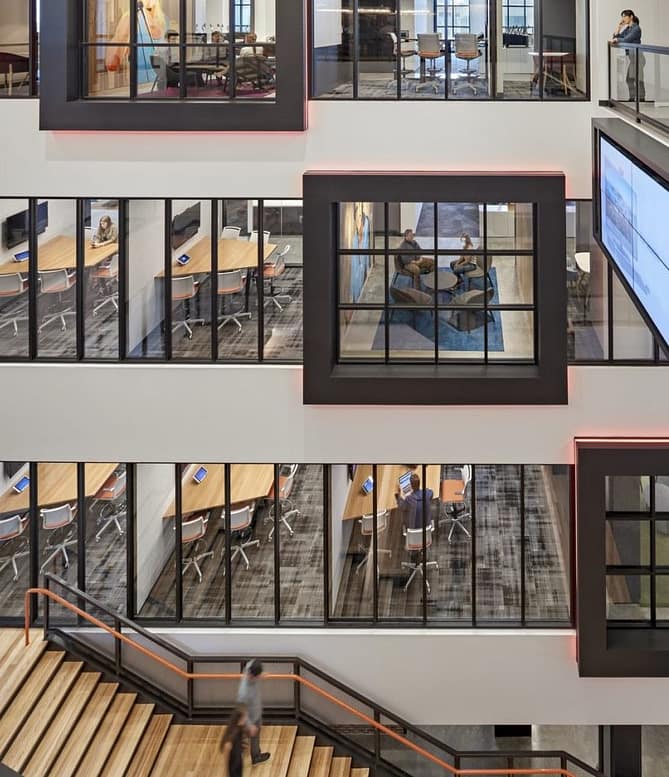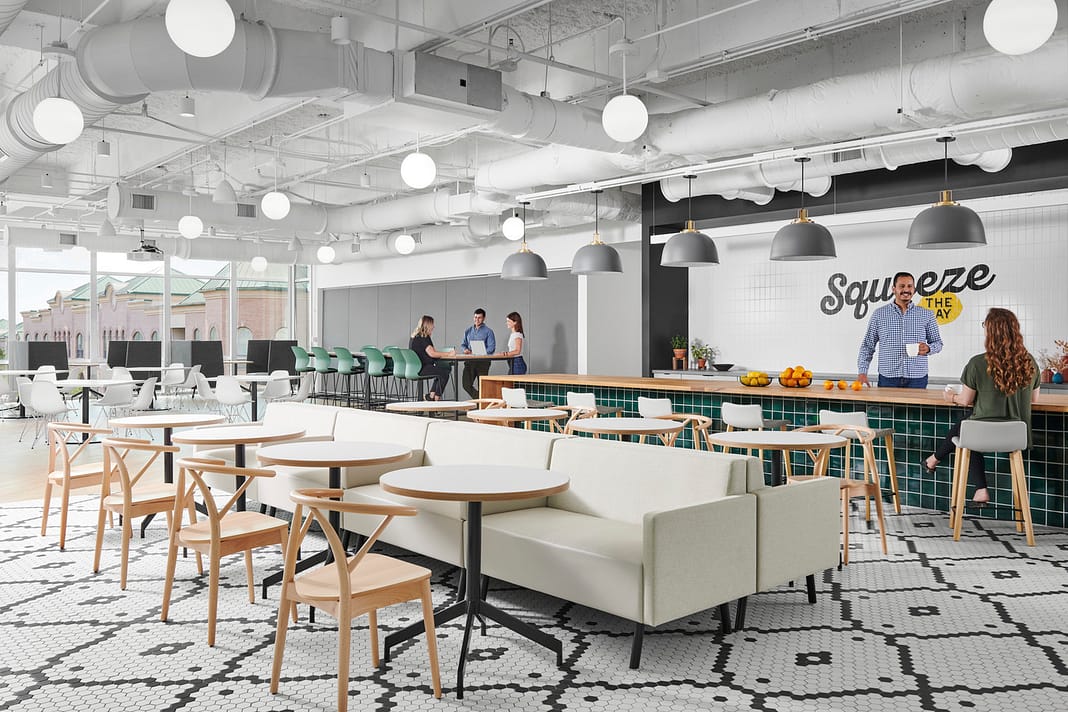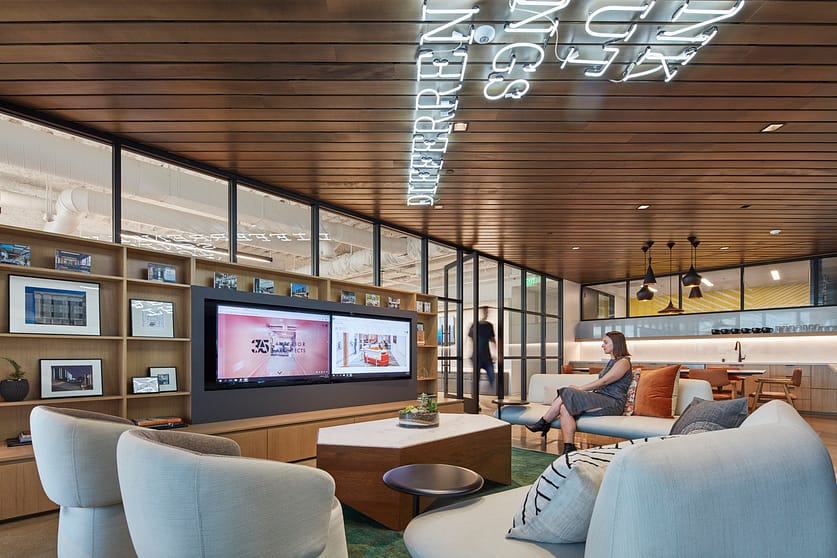By Russell Manthy | Principal
Problems with Inactivity
Whether working in the office, working from home, or a hybrid, maintaining healthy movement throughout the day is key to health and wellbeing. The World Health Organization (WHO) has identified physical inactivity as the fourth largest killer of the modern world, and it is overtaking obesity. A new category of people has developed who are ‘actively sedentary’. These are people who sit for most of the day but still do a modest amount of exercise. But the truth is that an hour of exercise is not really enough to balance out eight to ten hours of sitting.
We might think that working from home, which has been the norm for many in the past year, would have helped to mitigate this, but on average people’s workdays have actually been extended. It is important to consider the effects of healthy movement whether working from home or in the office. While most modern workplaces are equipped with relatively good furniture and equipment, such as sit-to-stand desks, ergonomic chairs, and keyboard trays, many people’s work-at-home setups do not offer those advantages which can exacerbate the issue. Long periods of work sitting on a kitchen stool or on a sofa without proper ergonomics can be even more problematic than the same duration in a properly equipped office space.
While sitting per se is not the real culprit, it is the duration and manner in which we sometimes sit that can cause issues.

Bernardino Ramazzini. Line engraving by J. G. Seiller, 1716. Copyrighted work available under Creative Commons Attribution only licence CC BY 4.0. Image via Wellcome Library, London.
This Should Not Be News
As far back as the eighteenth century the Italian physician Bernadino Ramazzini noted that messengers were in better health than tailors and cobblers. “Let tailors be advised to take physical exercise at any rate on holidays” he said.
Healthy Movement
It seems to be all about variety. According to many research studies and associated papers the key to overcoming this issue is changing it up throughout the day. A combination of sitting, standing, walking and some exercise seems to be the ideal blend for both physical and mental wellbeing.
The recent popularization and implementation of sit-to-stand desks in the workplace has gone far to help mitigate some of the problems. While there are various schools of thought, one recent and widely-accepted guide is the 20-8-2 rule which states that one should sit for no more than 20 minutes at a time, stand in one position for no more than 8 minutes at a time, and take a 2 minute moving break at least twice an hour to stretch or walk around.
The benefits of moving and varying your position throughout the day are numerous and include increased blood flow and improved metabolic function, among others. In addition to the physical health benefits, mental acuity and focus are sharpened when we move and change our positions and settings. All of these things can lead to greater productivity as well.
Walking is one of the most healthy things that we can do to increase physical and mental wellbeing. While there are challenges in some environments due to commute patterns, making a concerted effort to move around throughout the day is key. The technical definition of sedentary in terms of walking is someone who takes less than 5,000 steps per day. There are many fitness trackers, smartphones, and watch apps that can help us to set and monitor goals to keep our steps ‘in the green’.
Taking it to the next level, some people keep a resistance band or small hand weights at their desks to exercise a bit as they take their breaks!

“According to researchers at New Mexico Highlands University, the foot’s impact during walking and running sends pressure waves through the body that can increase the supply of blood to the brain. We all know that walking is good for us and this neurological information makes it even more clear why we feel so refreshed after a nice 30+ minute walk! Which leads me to believe that when we get stuck on an idea, it would be helpful to go for a walk and clear your mind to tackle the issue afterwards.”
Mary Lee Duff | Principal and Director of Workplace Strategy
The Supportive Workplace
There are many ways that workplace design can support healthy movement. Some are subtle; others are more direct.

The addition of interconnecting stairways can encourage employees to walk versus ride the elevators from floor-to-floor. Placing the stair in proximity to key amenities such as break areas and lounge and meeting spaces can further encourage people to utilize it. Also, the interconnecting stair provides an added cultural benefit of better connecting a multi-floor work environment.

Confidential Client, Plano, TX. Photography © Peter Molick.
The placement of amenities in an office environment can also help encourage movement throughout the day. A variety of different café options can be distributed throughout an office space each featuring a different type of drink or snack, such as coffee, tea, juice bars, etc. These become destinations for people to visit throughout the day. Other support spaces such as print and copy areas can be reduced in number and centrally located to encourage greater movement. Some clients have even provided pet areas within their campuses or office environments that allow people to bring their canine friends to work so they can exercise together.
Placing destination spaces in key or desirable areas of the floorplan, such as at the window line or in locations with better views, can also help to encourage use and movement throughout the day. Even the overall layout of the workstations and offices can be looked at in a thoughtful way to encourage a few more steps throughout the day. On a related note, for remote employees, firms can work with their contract furniture manufacturers to extend commercial discounts to people who want to upgrade their home offices to be more ergonomic.

Confidential Client, Cape Town. Photography © Adam Letch.
Once you have some of these spaces in place in your office it is important to tell the story. A strong experiential graphics program can help to explain and encourage their purpose. Interactive elements can allow people to track their progress and share thoughts and ideas with others. These types of elements can also help a company reinforce a focus on wellbeing.

”Graphics or art within the workplace can encourage behavior and inspire healthy activities, such as using the stairs more. Graphics can make a space like a fitness center or game room more lively to encourage more active behavior in those spaces. Analog or digital exhibits that are engaged by physical interactivity can more subtly increase movement just by being exciting enough to interact with. And, of course, signage can specifically direct people to walking tracks or highlight points of interest or step markers along the way.”
Julie Maggos | Principal and Senior Director of Experiential Graphics
When working from home it is still important to remember to take breaks and move around. A walk around the block or through your neighborhood can take the place of moving around your office space or campus. This can also be an opportunity to get more acquainted with your neighborhood or city. Many times we are so busy in our commutes that what we pass by tends to become invisible. This can be an opportunity to understand and appreciate the nature, architecture, and design that is around where we live.

Image via Bibliothèque nationale de France.
The Flaneur
The term flaneur is representative of a literary type from the nineteenth century. They are the urban explorer and a connoisseur of the street. The flaneur has a role in not just understanding the city but also becoming part of what gives the city its character.
Site-Specific Considerations
Where you locate your office can have an impact on people’s ability to increase their walking time throughout the day. When looking at a site for your office space, consider the neighborhood and walkable amenities available to the team. Is the site in an area where people will feel relatively safe out on the streets? The ability to do an errand on foot while near the office can encourage more healthy movement. Also, the availability of public transit and bike routes is key to encouraging people to make healthier choices about how they get to work. Providing employees with a neighborhood guide that points out restaurants, shops, and other points of interest can be helpful. Many employers accomplish this with a workplace experience app that is updated in real time.

The Intersect campus, Irvine, CA. Photography © Benny Chan.
Many suburban campus sites can be challenging as they have historically been designed around the car. However, this has been changing recently with many new and redeveloped sites incorporating a mix of office, retail, and residential space that can allow for a more walkable urban experience in a more suburban setting. Even sites that are not mixed use have been adding walking and jogging paths and creating space for food truck parking to help keep people more active and out of their cars. If people need to commute to the site by car, once there they may find more opportunities for moving about on foot.

“In our office I have an initiative called “Walk With Me” where team members take a one-on-one walk with me. The idea checks two key boxes: an opportunity for an informal one-on-one with people in a neutral setting, and getting up and moving our bodies outside the office for 20 to 30 minutes. The conversation is unstructured and can be anything my colleague wishes to discuss – personal, professional or spiritual.”
Helen Watts | Managing Director
Policy and Organizational Support
Even with all of the physical parts and pieces in place to encourage healthy movement in the workplace a strong policy element is needed to make it all come together and be successful. Organizations need to support and encourage their members to take advantage of these opportunities. The idea that overall productivity can be increased by taking some time to step away, move about, and clear your head can be a harder sell, but there is a growing body of evidence that supports this.
In addition to policies, sometimes the most effective way to support healthy movement in the workplace is to lead by example. Management and senior leadership need to participate in these programs and be seen visibly taking advantage of these spaces and amenities. This gives the organization permission to use them. Commercially available desktop and mobile applications can also encourage a healthy office environment by setting wellness reminders, advising users to stand up, drink water, take a break, etc.
No One Answer
There really is not a single silver bullet here. There are a number of components that all work in concert to create a working environment that encourages movement and wellbeing. It is up to us to make sure that we look at the many and varied factors that will create success.

